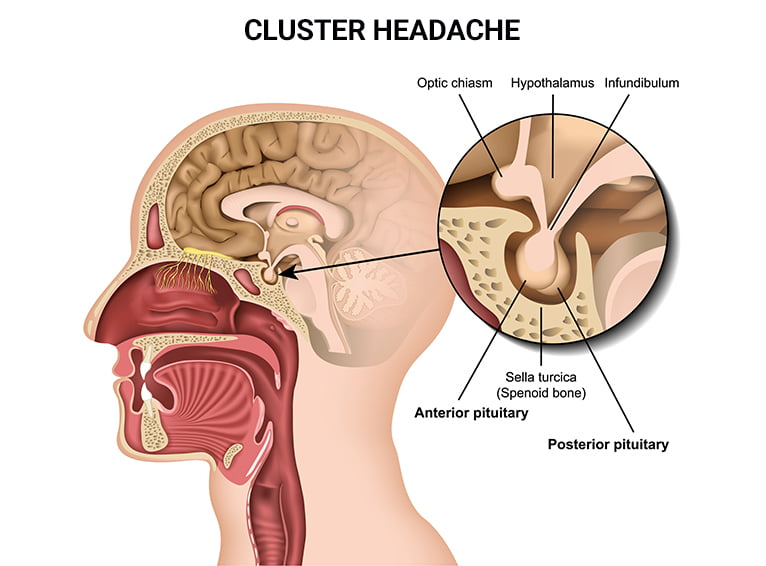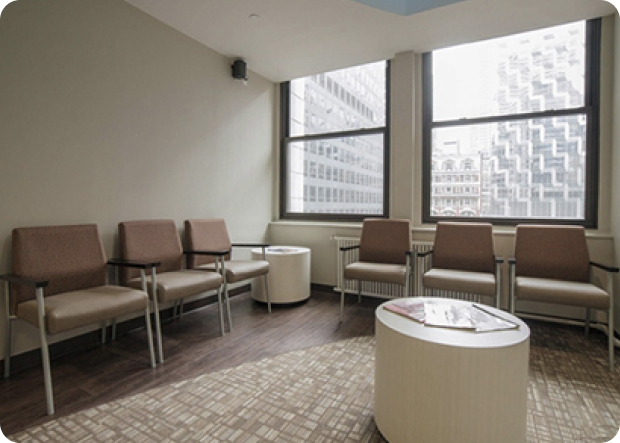Mild headache pain is a nuisance that’s usually treated with over-the-counter painkillers. But if you experience severe headache attacks for days around the same time every year, then it’s best to contact a healthcare provider immediately about cluster headaches and what you can do about them.
So what exactly are cluster headaches and how are they treated? Cluster headaches are extremely painful headaches that occur in a cluster period followed by headache-free periods. To manage cluster headache disorders during a headache cycle, patients can try alternative medicine, rational polypharmacy, and nerve block or trigger point injections.
Basic Information About Cluster Headaches
Headache pain is a universal human pain experience that millions of people suffer from. According to the International Headache Society (IHS), there are about 14 different headache groups and over 170 different headache types.
Headache disorders like tension headaches and migraine headaches are quite common, but they only usually cause mild to moderate headache pain. Some patients may also experience headaches accompanied by other symptoms, like sinus headaches that come with a runny nose or nasal congestion.
Rare headache disorders like true cluster headache may be unusual for most people but it causes pain so debilitating that patients have to stop and stay still to prevent it from worsening. Having repeated cluster headaches can cause severe pain that prevents patients from doing the things they love.

To help determine the best cluster headache treatment for a patient, it’s crucial to fully understand the headache condition basics first.
[callPoint]
1) What a Cluster Headache is
Cluster headaches are short but extremely painful headache attacks that persist for weeks or months at a time. Patients usually experience them around the same time every year, so they’re often confused with work stress or seasonal allergies.
Cluster headaches got their name because they come in groups or clusters before temporarily going away. Each cluster headache attack may last for about 30 to 45 minutes, but some people may feel it for a shorter or longer time. Patients may also experience up to 8 headache attacks within 24 hours. The cluster headache may go into remission for about a few months or years before returning.
2) What Causes Cluster Headaches
Cluster headaches are considered a primary headache disorder because there’s no underlying health condition that causes it. The exact cause of cluster headaches is still unknown, but experts classify it as a type of trigeminal autonomic cephalalgia.
When a patient experiences a cluster headache, a nerve pathway at the base of the brain is triggered. The affected trigeminal nerve is responsible for sensations of pain and heat in the face, which may explain why patients experience headache pain. The trigeminal nerve is found near the eye. It branches up to the forehead, cheeks, jaw, and above ear.
Patients in their cluster period may experience severe headache pain when exposed to triggers like:
- Alcohol
- Strong smells and cigarette smoke
- High altitudes
- Bright lights
- Heat
- Exercise
- Nitrate-containing food
- Cocaine
3) Signs and Symptoms of Cluster Headaches
A cluster headache attack may strike out of nowhere without warning, but some patients may experience migraine-like symptoms first. Some of the most common signs and symptoms of cluster headaches include:
- Excruciating pain around or behind one eye (it may radiate to other areas of the face, head, or neck)
- Pain on one side of the face
- Restlessness
- Excessive tearing
- Stuffy nose on the affected side
- Flushing or pale skin on the face
- Swelling around the affected eye
- Facial sweating on the affected side
- Drooping eyelid on the affected side
Patients usually pace around during a cluster headache attack. Some of them also experience migraine-like symptoms like sensitivity to light and sound, but it’s only felt on one side of the face.
Cluster periods last for several days, weeks, and months, but the duration and start date may become consistent every year. During a cluster period, patients may observe the following:
- Headaches that occur at least once every day
- Attacks that last anywhere from a few minutes to several hours
- Attacks that happen around the same time every day
- Night headache attacks about 1 to 2 hours after going to bed
4) How Cluster Headaches Are Diagnosed
Cluster headaches can be diagnosed because they have unique characteristics when it comes to the type of pain that patients experience, as well as the pattern of the headache pain they have. During a consultation, the doctor may ask for a detailed description of the pain, severity, location, and other associated symptoms.
Aside from checking the patient’s physical symptoms, headache diary, and previous medical records, doctors may also perform neurological examinations and imaging tests. Neurological exams assess the patient’s brain function while imaging tests (MRI and CT scan) rule out serious causes of headaches, like aneurysms or tumors.
5) Episodic vs. Chronic
Cluster headaches can be classified as chronic or episodic depending on the occurrence of cluster periods and remissions.
- Chronic cluster headache – persistent cluster headaches for more than a year without going into remission or with a remission period of fewer than 3 months.
- Episodic cluster headache – headaches that last from 1 week up to 1 year separated by remission periods of at least 3 months. A cluster period may last between 2 weeks to 3 months.
The good news is that cluster headaches get better as the patient ages. Their cluster periods become less frequent and their remission periods become longer.
What Makes Cluster Headaches Different?
Cluster headaches are unique among other common types of headache disorders because they’re severe but predictable due to their pattern. Cluster headache attacks may start suddenly, but some people may also experience visual disturbances similar to migraine symptoms before their headache begins.
Another thing to remember about cluster headaches is that they usually occur at night a few hours after the patient falls asleep. However, the pain is often enough to wake them up. Other patients may also start experiencing headache pain when they’re awake. The pain may peak about 5 to 10 minutes after the onset of cluster headaches.
Cluster headache pain occurs on one side of the head, but it may switch sides in some cases. Many patients describe the sensation as a deep piercing or burning pain behind or around their eye that extends to the forehead, teeth, nose, temples, neck, or shoulders.
Should You Consult a Doctor About Cluster Headaches?
If you experience sudden, severe headaches that you suspect might be cluster headaches, then it’s best to see a doctor immediately to rule out other medical conditions. They can also help you find the best cluster headache treatments.
Additionally, patients with a history of headaches are advised to see a headache specialist to check for pattern changes. They should consult with a doctor immediately if their headaches suddenly feel different. It’s crucial to call emergency care immediately if the patient experiences these signs and symptoms:
- An abrupt and severe headache similar to a thunderclap
- Headaches accompanied by other symptoms like fever, vomiting, stiff neck, mental confusion, numbness, seizure, or speaking difficulties
- Headaches after experiencing head injury or trauma, even if the accident seems minor
- An unusual but sudden, severe headache
- Headaches that worsen over a few days
Common Treatments for Cluster Headaches at Advanced Headache Center
Unfortunately, there are no known cures for cluster headaches yet. Most treatments are only meant to decrease the severity of headache pain, prevent frequent attacks, and shorten the cluster period.
Since the pain from cluster headaches appears abruptly, quick-acting medications are the best headache treatment option for most people. But at Advanced Headache Center, we may recommend the following treatments:
1) Rational Polypharmacy
Rational polypharmacy is the use of multiple medications to treat headache pain. Every medication recommended to a patient is meant to help them manage cluster headache symptoms without adding adverse effects like rebound headaches or medication dependency.
At Advanced Headache Center, our prescribed medicines can be used to stop or prevent cluster headaches. Here are some of them:
- Triptan and NSAIDs block pain signals from the brain and soothe the nerves that are involved in headache attacks. Combining triptans and NSAIDs improves oral absorption, resulting in better pain control.
- CGRP antagonists are helpful for chronic and episodic headaches because they prevent the dilation of blood vessels in the head.
- Calcium channel blockers are the first choice for most patients suffering from cluster headaches. They lower blood pressure, keep calcium out of the heart, and reduce the risk of severe headache pains. Most medications that contain calcium channel blockers are safe to take with other medicines.
2) Alternative Medicine
Taking too many headache medications may lead to side effects like rebound headaches. While our experts at Advanced Headache Center promise to guide you throughout your pharmacological treatments, we still understand that some patients prefer alternative or complementary approaches to relieve headache pain.
Here are some alternative treatments we offer at Advanced Headache Center:
- Physical therapy programs are one of the best treatment options that help patients manage pain conditions and injuries. Additionally, this approach also increases mobility, promotes healing, decreases the risk of future injury, and strengthens the body.
- Chiropractic care and manual spinal adjustments can be effective for headache disorders because they improve spinal function and alleviate unnecessary stress and pressure. Adjusting the joints, bones, and body tissues along the spine also has positive effects on the function of blood vessels.
- Acupuncture is a popular type of traditional Chinese medicine that promotes relaxation and relieves pain disorders. It involves inserting hair-like thin needles into the skin near the problem areas to stimulate the nervous system and increase blood flow in the head.
3) Trigger Point and Nerve Block Injections
If oral medications aren’t enough to stop or prevent cluster headache symptoms, a headache specialist may recommend trigger point or nerve block injections. This type of preventive treatment directly delivers medication to the patient’s trigger points or nerve blocks, resulting in quick-acting and long-lasting pain relief.
Here are some of the trigger point and nerve block injections we offer at Advanced Headache Center:
- Trigger point injections target the small and tender knots that form in the patient’s muscle or fascia. Each injection contains an anesthetic mixture to relax the trigger point and bring pain relief to the patient.
- Sphenopalatine ganglion block injections contain numbing medications or local anesthetics to block the sphenopalatine ganglion, a collection of nerves that are linked to the trigeminal nerve.
- Occipital nerve block injections are administered into the tissues around the occipital nerve to decrease swelling, pain, and inflammation. This type of nerve block injection works best for headaches around or at the back of the head.
Live Your Life Without Pain at Advanced Headache Center
Cluster headaches may be predictable as long as you’re aware of the pattern, but the pain they cause is still severe enough to prevent patients from getting through the day comfortably. Many treatment options may help relieve cluster headache pain, but it’s still best to consult a medical professional for accurate diagnosis and reliable treatment plans.
Advanced Headache Center is the trusted center when it comes to integrative treatments for cluster headaches. We also offer a wide range of different services for patients who are suffering from other types of headache disorders like migraine, sinus headaches, tension headaches, and more. Call us today to take the first step to your pain-free life.




